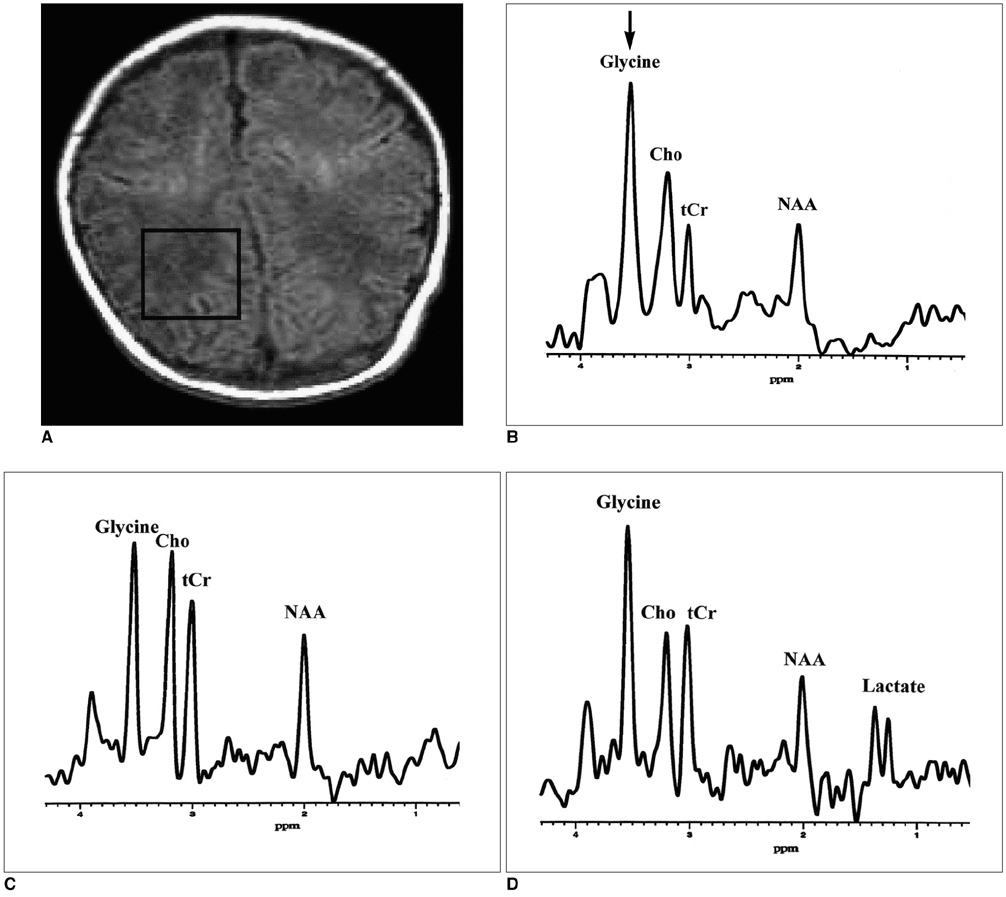Korean J Radiol.
2001 Dec;2(4):239-242. 10.3348/kjr.2001.2.4.239.
Localized Proton MR Spectroscopic Detection of Nonketotic Hyperglycinemia in an Infant
- Affiliations
-
- 1Department of Radiology, Asan Medical Center, University of Ulsan College of Medicine. cgchoi@amc.seoul.kr
- KMID: 754095
- DOI: http://doi.org/10.3348/kjr.2001.2.4.239
Abstract
- Nonketotic hyperglycinemia (NKH) is a rare metabolic brain disease caused by deficient activity of the glycine cleveage system. Localized proton MR spectroscopy (echo-time 166 msec), performed in an infant with the typical clinical and biochemical features of neonatal NKH, showed a markedly increased peak intensity at 3.55 ppm, which was assigned to glycine. Serial proton MR spectrosocpic studies indicated that glycine/choline and glycine/total creatine ratios correlated closely with the patient's clinical course. Proton MR spectroscopy was useful for the non-invasive detection and monitoring of cerebral glycine levels in this infant with NKH.
Keyword
MeSH Terms
Figure
Reference
-
1. Probst A, Cortes R, Palacios JM. The distribution of glycine receptors in the human brain: a light microscopic autoradiographic study using [3H]strychinine. Neuroscience. 1986. 17:11–35.2. Kemp JA, Leeson PD. The glycine binding site of the NMDA receptor: five years on. Trends Pharmacol Sci. 1993. 14:20–25.3. Heindel W, Kugel H, Roth B. Noninvasive detection of increased glycine content by proton MR spectroscopy in the brains of two infants with non-ketotic hyperglycinemia. Am J Neuroradiol. 1993. 14:629–635.4. Suzuki Y, Ueda H, Toribe Y. Proton MR spectroscopy of nonketotic hyperglycinemia. No To Hattatsu. 2001. 33:422–425.5. Gabis L, Parton P, Roche P, Lenn N, Tudorica A, Huang W. In vivo 1H magnetic resonance spectroscopic measurement of brain glycine levels in nonketotic hyperglycinemia. J Neuroimaging. 2001. 11:209–211.6. Michaelis T, Merboldt KD, Haenicke W, Gyngell ML, Bruhn H, Frahm J. On the identification of cerebral metabolites in localized 1H NMR spectra of human brain in vivo. NMR Biomed. 1991. 4:90–98.7. Press GA, Barshop BA, Haas RH, Nyhan WL, Glass RF, Hesselink JR. Abnormalities of the brain in nonketotic hyperglycinemia: MR manifestations. Am J Neuroradiol. 1989. 10:315–321.8. Frahm J, Hanefeld F. Bachelard HS, editor. Localized proton magnetic resonance spectroscopy of brain disorders in childhood. Magnetic resonance spectroscopy and imaging in neurochemistry. 1997. New York: Plenum Press;329–402.9. Schiffmann R, Kaye EM, Willis JK 3rd, Africk D, Ampola M. Transient neonatal hyperglycinemia. Ann Neurol. 1989. 25:201–203.10. Jackson AH, Applegarth DA, Toone JR, Kure S, Levy HL. Atypical nonketotic hyperglycinemia with normal cerebrospinal fluid to plasma glycine ratio. J Child Neurol. 1999. 14:464–467.
- Full Text Links
- Actions
-
Cited
- CITED
-
- Close
- Share
- Similar articles
-
- A novel association between cerebral sinovenous thrombosis and nonketotic hyperglycinemia in a neonate
- A Case of Korean Patient with Noketotic Hyperglycinemia: Diagnosed Based on CSF Amino Acid Analysis and Magnetic Resonance Spectroscopy
- Sequential magnetic resonance spectroscopic changes in a patient with nonketotic hyperglycinemia
- Acute Necrotizing Encephalopathy: Diffusion MR Imaging and Localized Proton MR Spectroscopic Findings in Two Infants
- In vivo Proton MR Spectroscopic Findings of Focal Hepatic Lesions: Initial Experience



